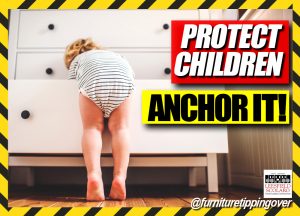After settling a claim on behalf of their client whose son was fatally injured in a furniture tip-over incident at home, Leesfield & Partners attorneys filed a lawsuit against the entities behind the safety standards that the furniture industry lives by. American Home Furnishings Alliance (AHFA) represents approximately 230 furniture manufacturers and distributors, and over 120 suppliers to the furniture industry worldwide. American Society for Testing and Materials (ASTM) has 30,000 members worldwide overseeing more than 12,500 product safety and technical standards. The Furniture Safety Subcommittee within ASTM oversees the furniture stability standard, F2057-19.
In 2017, Meghan DeLong retained Leesfield & Partners to file a wrongful death lawsuit following the death of her 2-year old son, Conner, in a furniture tip-over incident. In their testing, our experts discovered that the dresser in question would tip-over 100% of the time they replicated a young child climbing atop the very piece of furniture. Inversely, the defendant manufacturer argued that the dresser’s design satisfied ASTM’s voluntary standards, including tip-over prevention standards, and that their experts’ testing results showed 0% occurrence of the dresser tipping over. How could these two findings be true?
The answer is found in the ASTM standards themselves. The voluntary standard ASTM F2057-14, Standard Safety Specification Clothing Storage Units, establishes requirements for free-standing clothing storage units, (CSU) such as dressers, chests, and armoires, in the United States, and is intended to minimize the hazards associated with tipover. In practice however, the testing methods implemented by the furniture industry and approved by ASTM F2057-14, do not take into account dozens of crucial human factors that, if taken into account, render most pieces of furniture dangerous, thus defective.
 Florida Injury Lawyer Blawg
Florida Injury Lawyer Blawg


 Due to the relentless pursuit of justice by attorneys with the firm, a
Due to the relentless pursuit of justice by attorneys with the firm, a 